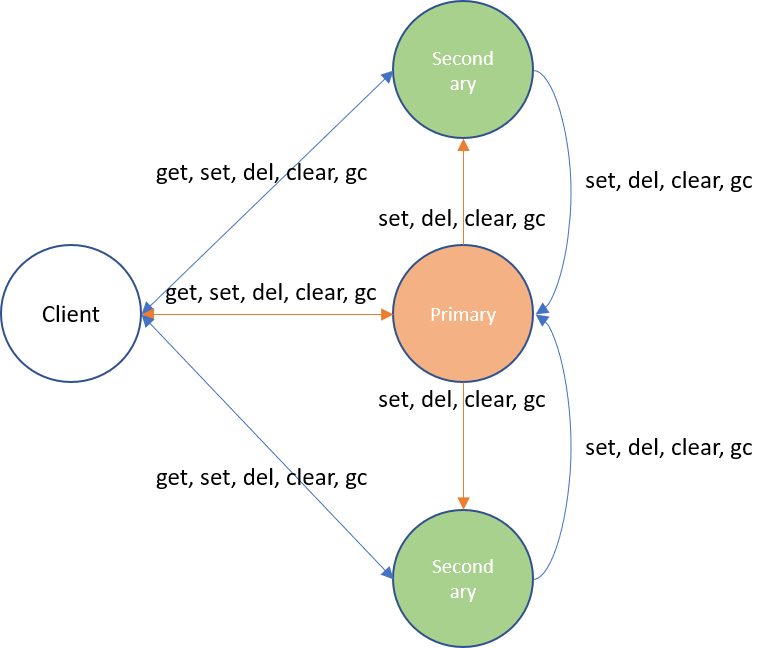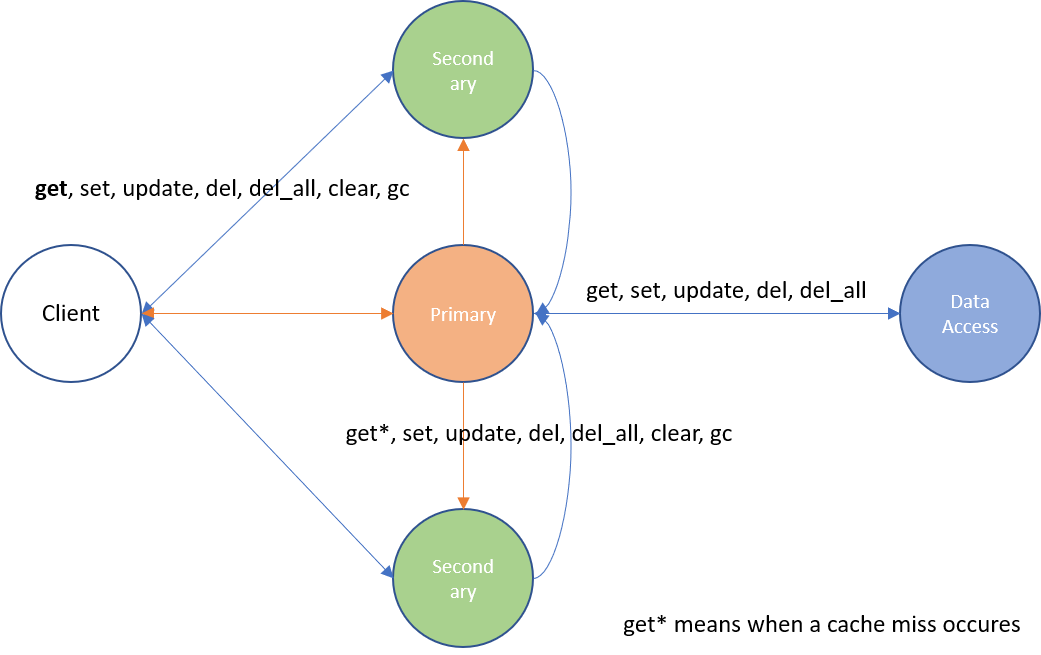Caching
Actor4j also supports caching, once volatile (see Figure 1) and persistent caching (see Figure 2). With persistent caching, the data is also stored in a database. A distinction is made between primary and secondaries, i.e., corresponding cache replicas can be created. Single leader replication [1] is currently used. All data changes initially go via the primary (“sequential consistency” [2].). Requested data change requests to secondaries are forwarded to the primary. The primary makes the data change and sends a notification of the data change to all secondaries. Read requests can be accepted by all replicas (primary, secondaries). By guaranteeing sequential consistency, atomic operations such as Compare And Set (CAS) are also possible. With persistent caching, data changes are also passed to the database (via DataAccessActor). Partitioning can be implemented by using several primary replicas (partitions) using range or hash partitioning [1].

Fig. 1: Volatile Caching in Actor4j

Fig. 2: Persistent Caching in Actor4j
Example with Volatile/Persistent Caching
The following two source code examples show volatile or persistent caching usage. A manager actor is created that builds up a cache on creation-time, and some key-value pairs are generated. At persistent caching, there must first create a DataAccessActor, which is responsible for persisting the data. Currently, a MongoDataAccessActor or an IMDBDataAccessActor can be used. Afterward, a client makes a request to a key and receives later asynchronously the corresponding key-value pair.
/* Example with Volatile Caching */
system.addActor(() -> new Actor("manager") {
protected VolatileActorCacheManager<String, String> manager;
@Override
public void preStart() {
manager = new VolatileActorCacheManager<String, String>(this, "cache");
addChild(manager.create(INSTANCES, 500));
manager.set("key1", "value1");
manager.set("key2", "value2");
manager.set("key3", "value3");
}
@Override
public void receive(ActorMessage<?> message) {
// empty
}
});
…
system.addActor(() -> new Actor("client") {
protected VolatileActorCacheManager<String, String> manager;
@Override
public void preStart() {
manager = new VolatileActorCacheManager<String, String>(this, "cache");
manager.get("key2");
}
@Override
public void receive(ActorMessage<?> message) {
Pair<String, String> pair = manager.get(message);
if (pair!=null)
System.out.printf("value for '%s': %s%n", pair.a(), pair.b());
}
});
/* Full examples under https://github.com/relvaner/actor4j/tree/master/actor4j-examples */
/* Example with Persistent Caching */
system.addActor(() -> new Actor("manager") {
protected PersistentActorCacheManager<String, ExampleEntity> manager;
@Override
public void preStart() {
ActorId dataAccess = addChild(() ->
new IMDBDataAccessActor<String, ExampleEntity>("dc"));
manager = new PersistentActorCacheManager<String, ExampleEntity>(
this, "cache", "key", "cache");
addChild(manager.create(INSTANCES, 500, dataAccess));
manager.set("key1", new ExampleObject("key1", "value1"));
manager.set("key2", new ExampleObject("key2", "value2"));
manager.set("key3", new ExampleObject("key3", "value3"));
}
@Override
public void receive(ActorMessage<?> message) {
// empty
}
});
…
system.addActor(() -> new Actor("client") {
protected PersistentActorCacheManager<String, ExampleEntity> manager;
@Override
public void preStart() {
manager = new PersistentActorCacheManager<String, ExampleEntity>(
this, "cache", "key", "cache");
manager.get("key2");
}
@Override
public void receive(ActorMessage<?> message) {
Pair<String, ExampleObject> pair = manager.get(message);
if (pair!=null)
System.out.printf("value for '%s': %s%n", pair.a(), pair.b().value();
}
});
/* Full examples under https://github.com/relvaner/actor4j/tree/master/actor4j-examples */
Publish-Subscribe
The Publish-Subscribe system (see Figure 3) in Actor4j is oriented on the Message Queue Telemetry Transport (MQTT) system, but currently in a minimalistic way. Only the subscription on topics and publishing to that topics works without any additional features (like Persistent Session, Retained Messages, Last Will and Testament [3]). A client actor can subscribe/unsubscribe to topics only over the broker actor. Messages can be published over the broker or directly to the topic actor if the address is known. The topic actor’s address can be determined over the broker, so direct communication to the topic actor is possible, which reduces message traffic.

Fig. 3: Publish-Subscribe in Actor4j
Example with Publish-Subscribe
For Publish-Subscribe, a broker that manages the subscription and unsubscription to topics is necessary. A broker will be first created in the example below. Next, a potential subscriber will be created. The subscriber makes a subscription to the topic by sending a “Subscribe” message. At last, a publisher determines the address of the topic actor created by the previous subscription. Finally, after it receives the address of the topic actor, a repeated task will be scheduled that publishes random numbers every 100 ms under this topic. The subscriber receives these numbers and prints them out on the console.
ActorId broker = system.addActor(() -> new BrokerActor());
ActorId subscriber = system.addActor(() -> new Actor("subscriberA") {
@Override
public void receive(ActorMessage<?> message) {
logger().debug(String.format(
"Message received (%s): %s", name,
((Publish<?>)message.value()).value()));
}
});
system.send(new ActorMessage<Subscribe>(new Subscribe("MyTopic"), 0, subscriber, broker));
system.addActor(() -> new Actor("publisher") {
protected Random random;
@Override
public void preStart() {
random = new Random();
send(ActorMessage.create(new Publish<String>(
"MyTopic", String.valueOf(random.nextInt(512))),
BrokerActor.GET_TOPIC_ACTOR, self(), broker));
}
@Override
public void receive(ActorMessage<?> message) {
if (message.tag()==BrokerActor.GET_TOPIC_ACTOR) {
system.timer().schedule(() -> ActorMessage.create(
new Publish<String>("MyTopic",
String.valueOf(random.nextInt(512))),
0, null, null), message.valueAsId(), 0, 100, TimeUnit.MILLISECONDS);
}
}
});
/* Full examples under https://github.com/relvaner/actor4j/tree/master/actor4j-examples */
Reactive Streams
The reactive streams implementation for Actor4j is oriented on the Reactive Streams specification [4][5]. The goal is to allow subscribers to backpressure if there are not able to process the data as common. The following components were implemented according to the specification: subscriber, publisher, and processor. A processor is a combination of publisher and subscriber. In Actor4j additionally, bulk operations are foreseen, so the amount of message exchange can be reduced, but the payload will be greater.
Example with Reactive Streams
In the below source code example, a publisher actor is created that broadcasts ingoing messages tagged with 1001 to their subscribers. Next, a subscriber actor is created, subscribing to the publisher and requesting ten values. The values will then be printed out on the console by the subscriber. These values are generated randomly every 100 ms over a timer and are sent to the publisher (messages tagged with 1001).
ActorId publisher = system.addActor(() -> new PublisherActor("publisher") {
@Override
public void receive(ActorMessage<?> message) {
super.receive(message);
if (message.tag()==1001)
broadcast(message.value());
}
});
system.addActor(() -> new SubscriberActor("subscriber") {
@Override
public void preStart() {
subscribe(publisher, (obj) -> logger().debug(String.format(
"At actor %s following value was received: %s"
, name, obj)), null, null);
request(10, publisher);
}
});
Random random = new Random();
system.timer().schedule(() -> ActorMessage.create(random.nextInt(512), 1001, null, null), publisher,
500, 100, TimeUnit.MILLISECONDS);
/* Full examples under https://github.com/relvaner/actor4j/tree/master/actor4j-examples */
References
[1] M. Kleppmann, “Designing Data-Intensive Applications: The Big Ideas Behind Reliable, Scalable, and Maintainable Systems,” O’Reilly Media, Inc, 2019.
[2]A. S. Tanenbaum and M. van Stehen, “Distributed Systems: Principles and Paradigms,” Pearson, 2008
[3] https://www.hivemq.com/mqtt-essentials/
[4] http://www.reactive-streams.org/
[5] https://github.com/reactive-streams/reactive-streams-jvm
